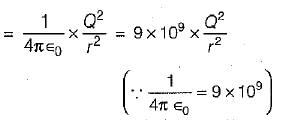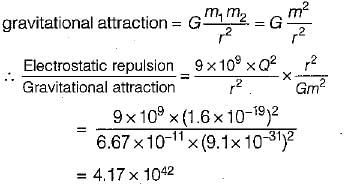Electrical Engineering (EE) Exam > Electrical Engineering (EE) Questions > What is the ratio of electrostatic repulsion ...
Start Learning for Free
What is the ratio of electrostatic repulsion and gravitational attraction between two electrons?
Given:
Q = Charge on an electron = 1.6 x 10-19C
G = Gravitation constant = 6.67 x 10-11 Nm2/kg2
m = Mass of an electron = 9.1 x 10-31 kg
Given:
Q = Charge on an electron = 1.6 x 10-19C
G = Gravitation constant = 6.67 x 10-11 Nm2/kg2
m = Mass of an electron = 9.1 x 10-31 kg
- a)3.23 x1042
- b)4.17 x1042
- c)2.33 x 1042
- d)1.47 x 1042
Correct answer is option 'B'. Can you explain this answer?
Verified Answer
What is the ratio of electrostatic repulsion and gravitational attract...
By columb’s law,


Also, by Newton's law of gravitation,



Also, by Newton's law of gravitation,

Most Upvoted Answer
What is the ratio of electrostatic repulsion and gravitational attract...
To find the ratio of electrostatic repulsion to gravitational attraction between two electrons, we need to calculate both values separately and then divide them.
1. Calculation of electrostatic repulsion:
The electrostatic force between two charged particles can be calculated using Coulomb's law, which states that the force is directly proportional to the product of the charges and inversely proportional to the square of the distance between them.
The formula for the electrostatic force (F_e) between two point charges q1 and q2 separated by a distance r is given by:
F_e = (k * q1 * q2) / r^2
Where:
- k is the electrostatic constant (k = 9 x 10^9 Nm^2/C^2)
- q1 and q2 are the charges on the particles
In this case, both charges are electrons, so q1 = q2 = 1.6 x 10^-19 C.
Let's assume the distance between the electrons is d.
Therefore, the electrostatic force between the electrons is:
F_e = (k * (1.6 x 10^-19) * (1.6 x 10^-19)) / d^2
2. Calculation of gravitational attraction:
The gravitational force between two objects can be calculated using Newton's law of universal gravitation, which states that the force is directly proportional to the product of the masses and inversely proportional to the square of the distance between them.
The formula for the gravitational force (F_g) between two objects with masses m1 and m2 separated by a distance r is given by:
F_g = (G * m1 * m2) / r^2
Where:
- G is the gravitational constant (G = 6.67 x 10^-11 Nm^2/kg^2)
- m1 and m2 are the masses of the objects
In this case, both masses are the mass of an electron, which is 9.1 x 10^-31 kg.
Let's assume the distance between the electrons is d.
Therefore, the gravitational force between the electrons is:
F_g = (G * (9.1 x 10^-31) * (9.1 x 10^-31)) / d^2
3. Ratio of electrostatic repulsion to gravitational attraction:
To find the ratio of the electrostatic repulsion to gravitational attraction, we divide the electrostatic force (F_e) by the gravitational force (F_g):
Ratio = F_e / F_g = ((k * (1.6 x 10^-19) * (1.6 x 10^-19)) / d^2) / ((G * (9.1 x 10^-31) * (9.1 x 10^-31)) / d^2)
Simplifying the equation, we can cancel out the common terms and obtain the final answer:
Ratio = (k / G) * ((1.6 x 10^-19)^2 / (9.1 x 10^-31)^2)
Plugging in the given values for k and G, we can calculate the ratio:
Ratio = (9 x 10^9 / 6.67 x 10^-11) * ((1.6 x 10^-19)^2 / (9.1 x 10^-31)^2)
Calculating the numerical value of the ratio gives us
1. Calculation of electrostatic repulsion:
The electrostatic force between two charged particles can be calculated using Coulomb's law, which states that the force is directly proportional to the product of the charges and inversely proportional to the square of the distance between them.
The formula for the electrostatic force (F_e) between two point charges q1 and q2 separated by a distance r is given by:
F_e = (k * q1 * q2) / r^2
Where:
- k is the electrostatic constant (k = 9 x 10^9 Nm^2/C^2)
- q1 and q2 are the charges on the particles
In this case, both charges are electrons, so q1 = q2 = 1.6 x 10^-19 C.
Let's assume the distance between the electrons is d.
Therefore, the electrostatic force between the electrons is:
F_e = (k * (1.6 x 10^-19) * (1.6 x 10^-19)) / d^2
2. Calculation of gravitational attraction:
The gravitational force between two objects can be calculated using Newton's law of universal gravitation, which states that the force is directly proportional to the product of the masses and inversely proportional to the square of the distance between them.
The formula for the gravitational force (F_g) between two objects with masses m1 and m2 separated by a distance r is given by:
F_g = (G * m1 * m2) / r^2
Where:
- G is the gravitational constant (G = 6.67 x 10^-11 Nm^2/kg^2)
- m1 and m2 are the masses of the objects
In this case, both masses are the mass of an electron, which is 9.1 x 10^-31 kg.
Let's assume the distance between the electrons is d.
Therefore, the gravitational force between the electrons is:
F_g = (G * (9.1 x 10^-31) * (9.1 x 10^-31)) / d^2
3. Ratio of electrostatic repulsion to gravitational attraction:
To find the ratio of the electrostatic repulsion to gravitational attraction, we divide the electrostatic force (F_e) by the gravitational force (F_g):
Ratio = F_e / F_g = ((k * (1.6 x 10^-19) * (1.6 x 10^-19)) / d^2) / ((G * (9.1 x 10^-31) * (9.1 x 10^-31)) / d^2)
Simplifying the equation, we can cancel out the common terms and obtain the final answer:
Ratio = (k / G) * ((1.6 x 10^-19)^2 / (9.1 x 10^-31)^2)
Plugging in the given values for k and G, we can calculate the ratio:
Ratio = (9 x 10^9 / 6.67 x 10^-11) * ((1.6 x 10^-19)^2 / (9.1 x 10^-31)^2)
Calculating the numerical value of the ratio gives us

|
Explore Courses for Electrical Engineering (EE) exam
|

|
Similar Electrical Engineering (EE) Doubts
What is the ratio of electrostatic repulsion and gravitational attraction between two electrons?Given:Q = Charge on an electron = 1.6 x 10-19CG = Gravitation constant = 6.67 x 10-11 Nm2/kg2m = Mass of an electron = 9.1 x 10-31 kga)3.23 x1042b)4.17 x1042c)2.33 x 1042d)1.47 x 1042Correct answer is option 'B'. Can you explain this answer?
Question Description
What is the ratio of electrostatic repulsion and gravitational attraction between two electrons?Given:Q = Charge on an electron = 1.6 x 10-19CG = Gravitation constant = 6.67 x 10-11 Nm2/kg2m = Mass of an electron = 9.1 x 10-31 kga)3.23 x1042b)4.17 x1042c)2.33 x 1042d)1.47 x 1042Correct answer is option 'B'. Can you explain this answer? for Electrical Engineering (EE) 2025 is part of Electrical Engineering (EE) preparation. The Question and answers have been prepared according to the Electrical Engineering (EE) exam syllabus. Information about What is the ratio of electrostatic repulsion and gravitational attraction between two electrons?Given:Q = Charge on an electron = 1.6 x 10-19CG = Gravitation constant = 6.67 x 10-11 Nm2/kg2m = Mass of an electron = 9.1 x 10-31 kga)3.23 x1042b)4.17 x1042c)2.33 x 1042d)1.47 x 1042Correct answer is option 'B'. Can you explain this answer? covers all topics & solutions for Electrical Engineering (EE) 2025 Exam. Find important definitions, questions, meanings, examples, exercises and tests below for What is the ratio of electrostatic repulsion and gravitational attraction between two electrons?Given:Q = Charge on an electron = 1.6 x 10-19CG = Gravitation constant = 6.67 x 10-11 Nm2/kg2m = Mass of an electron = 9.1 x 10-31 kga)3.23 x1042b)4.17 x1042c)2.33 x 1042d)1.47 x 1042Correct answer is option 'B'. Can you explain this answer?.
What is the ratio of electrostatic repulsion and gravitational attraction between two electrons?Given:Q = Charge on an electron = 1.6 x 10-19CG = Gravitation constant = 6.67 x 10-11 Nm2/kg2m = Mass of an electron = 9.1 x 10-31 kga)3.23 x1042b)4.17 x1042c)2.33 x 1042d)1.47 x 1042Correct answer is option 'B'. Can you explain this answer? for Electrical Engineering (EE) 2025 is part of Electrical Engineering (EE) preparation. The Question and answers have been prepared according to the Electrical Engineering (EE) exam syllabus. Information about What is the ratio of electrostatic repulsion and gravitational attraction between two electrons?Given:Q = Charge on an electron = 1.6 x 10-19CG = Gravitation constant = 6.67 x 10-11 Nm2/kg2m = Mass of an electron = 9.1 x 10-31 kga)3.23 x1042b)4.17 x1042c)2.33 x 1042d)1.47 x 1042Correct answer is option 'B'. Can you explain this answer? covers all topics & solutions for Electrical Engineering (EE) 2025 Exam. Find important definitions, questions, meanings, examples, exercises and tests below for What is the ratio of electrostatic repulsion and gravitational attraction between two electrons?Given:Q = Charge on an electron = 1.6 x 10-19CG = Gravitation constant = 6.67 x 10-11 Nm2/kg2m = Mass of an electron = 9.1 x 10-31 kga)3.23 x1042b)4.17 x1042c)2.33 x 1042d)1.47 x 1042Correct answer is option 'B'. Can you explain this answer?.
Solutions for What is the ratio of electrostatic repulsion and gravitational attraction between two electrons?Given:Q = Charge on an electron = 1.6 x 10-19CG = Gravitation constant = 6.67 x 10-11 Nm2/kg2m = Mass of an electron = 9.1 x 10-31 kga)3.23 x1042b)4.17 x1042c)2.33 x 1042d)1.47 x 1042Correct answer is option 'B'. Can you explain this answer? in English & in Hindi are available as part of our courses for Electrical Engineering (EE).
Download more important topics, notes, lectures and mock test series for Electrical Engineering (EE) Exam by signing up for free.
Here you can find the meaning of What is the ratio of electrostatic repulsion and gravitational attraction between two electrons?Given:Q = Charge on an electron = 1.6 x 10-19CG = Gravitation constant = 6.67 x 10-11 Nm2/kg2m = Mass of an electron = 9.1 x 10-31 kga)3.23 x1042b)4.17 x1042c)2.33 x 1042d)1.47 x 1042Correct answer is option 'B'. Can you explain this answer? defined & explained in the simplest way possible. Besides giving the explanation of
What is the ratio of electrostatic repulsion and gravitational attraction between two electrons?Given:Q = Charge on an electron = 1.6 x 10-19CG = Gravitation constant = 6.67 x 10-11 Nm2/kg2m = Mass of an electron = 9.1 x 10-31 kga)3.23 x1042b)4.17 x1042c)2.33 x 1042d)1.47 x 1042Correct answer is option 'B'. Can you explain this answer?, a detailed solution for What is the ratio of electrostatic repulsion and gravitational attraction between two electrons?Given:Q = Charge on an electron = 1.6 x 10-19CG = Gravitation constant = 6.67 x 10-11 Nm2/kg2m = Mass of an electron = 9.1 x 10-31 kga)3.23 x1042b)4.17 x1042c)2.33 x 1042d)1.47 x 1042Correct answer is option 'B'. Can you explain this answer? has been provided alongside types of What is the ratio of electrostatic repulsion and gravitational attraction between two electrons?Given:Q = Charge on an electron = 1.6 x 10-19CG = Gravitation constant = 6.67 x 10-11 Nm2/kg2m = Mass of an electron = 9.1 x 10-31 kga)3.23 x1042b)4.17 x1042c)2.33 x 1042d)1.47 x 1042Correct answer is option 'B'. Can you explain this answer? theory, EduRev gives you an
ample number of questions to practice What is the ratio of electrostatic repulsion and gravitational attraction between two electrons?Given:Q = Charge on an electron = 1.6 x 10-19CG = Gravitation constant = 6.67 x 10-11 Nm2/kg2m = Mass of an electron = 9.1 x 10-31 kga)3.23 x1042b)4.17 x1042c)2.33 x 1042d)1.47 x 1042Correct answer is option 'B'. Can you explain this answer? tests, examples and also practice Electrical Engineering (EE) tests.

|
Explore Courses for Electrical Engineering (EE) exam
|

|
Signup for Free!
Signup to see your scores go up within 7 days! Learn & Practice with 1000+ FREE Notes, Videos & Tests.
























